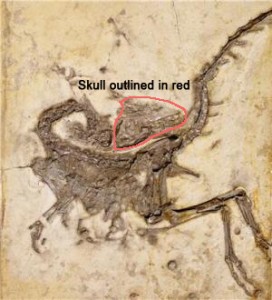Dinosaur Death Throes – Updated Research
An Explanation of Dinosaur “Death Postures”
Many theropod dinosaur fossils if they are discovered as a reasonably complete and articulated specimen depict the animal in a twisted posture, with the neck and tail arched over the spine. In the past these unusual positions have been interpreted as the “death spasms” of the animal. Such postures are not restricted to dinosaurs, fossils of birds and other reptiles, especially those with long tails and necks show a similar stance as it were. New research suggests that these positions are a result of decomposition and bare no relation to the “death throes” of the animal concerned.
More or less complete and articulated skeletons of dinosaurs with a long neck and tail often exhibit a body posture in which the head and neck are recurved over the back of the animal. This posture, also known from Late Jurassic “proto-bird) Archaeopteryx (A. lithographica) , has been fascinating palaeontologists since the first theropod (mainly meat-eating), dinosaur fossils were discovered. The pose is often referred to as the “opisthotonic posture”.
To read an earlier article on dinosaur “death throes”: Death Throes – Not Quite What they Seem.
Death Postures
The opisthotonic posture relates to an accessory symptom of tetanus, well known to doctors and to veterinarians. Usually, an “opisthotonic posture” like that is the result of vitamin deficiency, poisoning or damage to the cerebellum.
The cerebellum is a brain region that controls fine muscle movement, which includes the body’s antigravity muscles that keep the head and tail upright. If the cerebellum ceases to function, the antigravity muscles will clench at full force, tipping the head and tail back, and contracting the limbs.
A syndrome like that as a petrified expression of death throes was discussed for the first time about 100 years ago for some vertebrate fossils, but the acceptance of this interpretation declined during the following decades. In 2007, this “opisthotonus hypothesis” was newly posted by a veterinarian and a palaeontologist.
Five years later, two scientists from Switzerland and Germany have re-evaluated the revitalised “opisthotonus hypothesis” and examined one of its icons, the famous bipedal dinosaur Compsognathus longipes from the “Solnhofen Archipelago” (Germany). An area of Upper Jurassic strata, laid down in what was an extensive lagoonal network.
A Picture of a Compsognathus Dinosaur Fossil Showing the Death Posture
Picture credit: G. Janßen, O. Rauhut, Bayerische Staatssammlung für Paläontologie und Geologie)
Sedimentologist Achim Reisdorf from University of Basel’s Institute of Geology and Palaeontology comments:
“In our opinion, the most critical point in the newly discussed scenario of the preservation of an opisthotonic posture in a fossil is the requirement that terrestrial vertebrates must have been embedded immediately after death without substantial transport. But consigning a carcass from land to sea and the following need of sinking through the water column for only a few centimetres or metres is nothing else.”
Postmortem Alterations of the Skeleton
Convinced that the back arching was generated, not by death throes, but by postmortem alterations of a decaying carcass, the researchers made experiments with plucked chicken necks and thoraxes, immersed in water. Submersed in water, the necks spontaneously arched backwards for more than 90 degrees. Ongoing decay for some months even increased the degree of the pose.
Thorough preparation and dissection combined with testing revealed that a special ligament connecting the vertebrae at their upper side was responsible for the re-curved necks in the chickens. This ligament, the so-called Ligamentum elasticum, is pre-stressed in living chickens, but also in dead ones.
One of the scientists involved in carrying out this, somewhat unusual and macabre research, palaeontologist Michael Wuttke from the Section of Earth History in the General Department for the Conservation of Cultural History Rhineland Palatinate in Mainz (Germany) stated:
“Veterinarians may often have to deal with sick and dying animals, where they see the opisthotonic posture in many cases. Vertebrate palaeontologists, however, who want to infer the environment in which the animals perished and finally were embedded have to elucidate postmortem processes and bio-mechanical constraints too”.
It is this tensile, ligament, essential for the effective support of a theropod dinosaur’s long tail and neck that could be responsible for the classic – “dinosaur death pose”.
Michael went onto add:
“The preloaded ligament helped them [dinosaurs] saving energy in their terrestrial mode of life. Following their death, at which they were immersed in water, the stored energy along the vertebra was strong enough to arch back the spine, increasingly so as more and more muscles and other soft parts were decaying. It is a special highlight that, in the Compsognathus specimen, these gradual steps of re-curvature can be substantiated, too. Therefore, bio-mechanics is ruling the postmortem weird posture of a carcass in a watery grave, not death throes.”
For replicas and figures of Compsognathus and other theropod dinosaurs: Papo Models of Prehistoric Animals.


